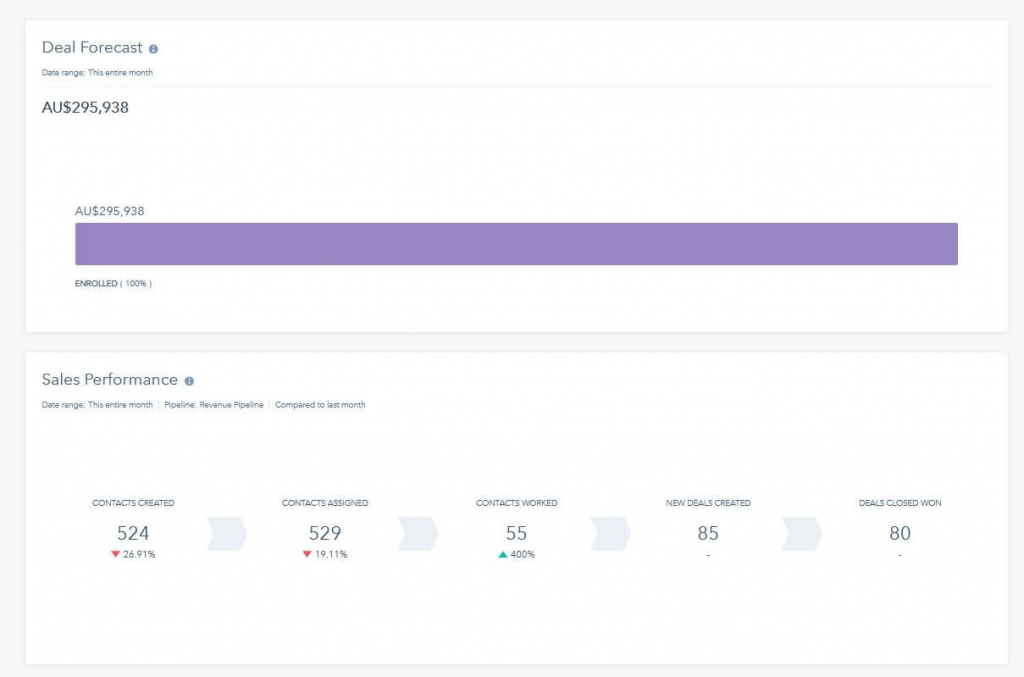If marketing doesn’t have visibility around what sales is doing and vice versa, then you’re potentially losing revenue because each team is not aware of the entire customer journey. Sales conversations lack context and marketing lacks data to send personalised segmented messages. That’s just two examples to start with!
So in this article, we’re going to delve into:
What Having Full Visibility Over Your Sales and Marketing Activities Looks Like
If you’re thinking about improving your birds eye sales and marketing visibility, we recommend asking yourself these questions first:
What does it mean to you? What do you want to be able to see around your sales and marketing activities?
From the perspective of our HubSpot specialists at RedPandas, having full visibility over your sales and marketing activities is all about having a clear, holistic picture around every single interaction a prospect has had with your business across both the marketing and the sales cycle.
“It’s all about having full visibility over every interaction up until they sign that proposal or send us that cheque, it’s about saying ‘let us understand as a business how our buyer is buying so that we can support them better in the future”.
Tasha, one of our Accredited HubSpot Trainers.
Having full visibility means that when we gain any information from a potential customer, such as their name and email, we should be able to see all of the following at different stages of the funnel.
At the top of funnel, we should:
- Know where they came from and how they found us (something called the ‘original source’, which we will dive deep into a little later in this article)
- Be aware of exactly what pieces of content they have consumed from us (such as blog articles, videos, social media posts and ads)
- Be aware of the level of engagement any single prospect is having with our content through having visibility around metrics such as bounce rate. This helps us differentiate between prospects, allowing us to spend more of our precious time on engaging those who are more likely to buy.
At the middle of the funnel, we should:
- Know what emails our sales team has sent to prospects and who sent those emails
- Know what event invitations have been sent to prospects
- Have clarity on how each prospect is interacting with these things (for example, are they opening the email, are they clicking links in the email, and so on).

At the bottom of the funnel, we should:
- Know whether or not our sales team is trying to make contact with the prospect,
- Know exactly what we did when we communicated with prospects. For example, did we call them, and if so, what did we call them about? What was said, and how did the call go?
- See when a prospect moves from being a prospect to being a customer.
Having full visibility over your sales and marketing activities is being able to see every activity within these two departments from a customer centric perspective, all in one place. In other words, it means we can see exactly what our prospects are looking at and how they are interacting with us, at every stage of the funnel.
When we have full visibility, we have full control. It becomes mind-blowingly powerful, because we can see which specific actions led to success, and we can double down on those.
For example, we might see that a prospect who has just become a customer read one specific blog article before the sales call that they converted on, and that the very first thing they interacted with was a specific ad from Facebook. In this case, we can attribute the revenue to these different pieces of content, and by doing so we can focus on the things that generate more revenue and speed up the growth of our business.

So, we’ve covered what having full visibility over your sales and marketing activities is, and why it is important for the growth of your business. Next, let’s look at what happens when we don’t have full visibility.
What Happens When We Don’t Have Full Visibility Over Our Sales & Marketing Activities?
When we don’t have full visibility over our sales and marketing activities, we actually lose revenue, and more importantly, we lose control over the growth of our business.
Imagine this scenario.
You start using paid advertising. You generate over 1,000 leads. You start using email marketing to engage these leads, and you begin calling them. In the meantime, you’re writing blog articles and posting on social media. These prospects are looking at your social posts, blog articles, and emails – you know this because you can see the metrics on these platforms for this.
However, you can’t see which specific blog articles and emails a specific prospect has looked at. So, you call one of your prospects, and thirty minutes into the call, you realise that this particular prospect hasn’t actually engaged with any of your content, other than that first advertisement. You just wasted your time (or your company’s sales team wasted their time). That’s lost revenue right there – time spent with nothing gained – and it could have been avoided. You might be wondering, how is it a waste of time calling my prospect if they’ve filled in a form from an ad – isn’t that a good use of our time? Well, you’re always going to have a mix of warm leads and cold leads. This means that a portion of leads will be closer to purchasing (warm) than another portion (cold). When you call prospects without knowing whether they are cold or warm, you risk calling cold prospects, which can be a time waster.
Next, you ring another prospect, and this time, you find out that they’ve read some of your blog articles and web pages, because they’re aware of some of the services you offer. However, you have no idea which specific articles they’ve read. You know that they might be interested in a service, but you’re unsure of which service they might be interested in. So, your sales call becomes one in which you have to figure all of this out, and then, at the end, you might find that they aren’t even a good fit for your company.
But what if you knew exactly what questions they have before your meeting together? What if you knew exactly what they were interested in, before you even jumped on the phone with them? What you’ll find is that the length of the meeting is shortened, and the conversion rate is higher.
Clearly, you can see how not having full visibility over your sales and marketing activities can become a massive problem for sales, resulting in wasted time and thus lost revenue. On top of this, marketing teams may struggle as well in this predicament, as they won’t know what specific marketing efforts have led to revenue from closed deals.
So, How Does HubSpot Give Us Full Visibility Over Our Sales & Marketing Activities?
We can ensure we have full visibility over sales and marketing activities by using a software like HubSpot to track all of these things.
HubSpot is an all-in-one CRM which allows us to collect and engage leads across the top of funnel, middle of funnel, and bottom of funnel. It connects all of our marketing and sales channels in one place so that we can get a birds eye view of everything. But, how does it actually track everything for us?
It all has to do with ‘original source’ attribution. This allows us to understand exactly where a contact comes from. For example, whether a contact has come from Facebook, or from viewing a blog article through organic SEO.
On HubSpot, there are a set amount of specific original sources that a user can fit into, and then within each original source we can drill into it even further to find out more. For example, if we know a contact came from Facebook, we can then dive deeper to see what campaign, ad set and specific ad they came from.
From here, we can then track exactly what this contact is doing; what pages they visit on our website, how long they stay on those pages for, what social media posts they interact with, what ads they see and convert on, what emails they open and engage with, what communication our sales team has had with them, and most importantly, the amount of revenue that has been generated as a result.
Here’s how HubSpot tracks all of this:
- First, HubSpot attaches a cookie to any user that visits your website. This follows the user online and tracks them.
- Then, when a user becomes a contact by filling out a form on your website, HubSpot attaches that browser cookie to that specific contact record in your CRM. In other words, you go from just knowing that a particular user with a particular IP address looked at a specific page on your website to knowing that the user whose first name is John and last name is Smith visited a specific page on your website.
- Then, HubSpot can track all the marketing related activity (such as email automation) to the contact record, and the sales related activity (such as phone calls) to the deal record. HubSpot can automatically associate contact and deal records, which means you can see what specific marketing and sales activities led to actual revenue in the bank.
In other words, when a contact visits a page on your website and a deal associated to that contact has been won, you are able to see which pages of your website the contact visited, including the first and last pages they visited, which gives you an indication on what drove this user to purchase. In this way, we can truly measure ROI from specific pieces of content on our website.
If your company doesn’t have full visibility over all of this, then we definitely recommend looking into HubSpot to help support your team in having the information that will lead to increased revenue.
Can You Get The Same Result With Software Other Than HubSpot?
In short, yes, but you’ll have to do a bunch of workarounds to get the same result, and even then, it can be really difficult to achieve the same outcome. Let’s actually dive deep into this.
What a lot of other softwares don’t do is ‘original source’ attribution tracking, which allows us to understand exactly where a contact came from. On top of this, the best part of the HubSpot sales pipeline is that it is connected to contact objects, so everything is all in the same place, allowing for powerful visibility capabilities. If we compare this to a software like Salesforce, we can see a huge difference.
In Salesforce, marketing and sales activities are not connected, which means salespeople can’t see the behaviour of contacts over time. Invaluable information that takes effect on sales teams.
On the other hand, HubSpot provides you with a single customer view so that you can see all of the marketing and sales activities related to that contact holistically. This has a positive powerful impact on both marketing and sales teams, resulting in higher close rates and ultimately more revenue.
Now, while other out of the box softwares don’t give you this holistic view which is essential to having full visibility and increased growth, some of these other softwares do give you original source attribution. The only difference is that they make it much harder for you to get the information, and to be honest, we don’t really know why.
HubSpot gives you original source attribution for free (plus much more if you’re on a paid plan with HubSpot). On the other hand, a company like Salesforce will make you fork out an enormous amount of money just to use their software, and even then they don’t prioritise original source attribution, making it extremely difficult for you to find this information in their system. Active Campaign is another software which offers you this information, but also only on paid plans.
All in all, you can get the same information around original source attribution with other software other than HubSpot, but it just might be harder or more costly for you to get your hands on that information. Also, other software does not connect marketing and sales activities like HubSpot does, making HubSpot the clear winner in our eyes when it comes to having full visibility over your sales and marketing activities.
What You Need Before You Even Start Thinking About Full Visibility
Before you even start thinking about having full visibility, you need to have one specific thing in place to ensure your future efforts around achieving full visibility are not wasted.
And that is, you need to have a birds-eye view of your entire customer journey. What does this mean?
A customer journey is represented in HubSpot as lifecycle stages. Lifecycle stages are everything that occurs from marketing, to sales, and beyond.
But what does a customer journey look like?

At RedPandas, the first thing we do when we work with you on your HubSpot onboarding or optimisation is to map out the entire customer journey, because it’s the most important thing to do. We’ve developed an exact process to figure out what your customer journey map should look like.
So, bottom line – before you get excited about the shiny objects, start by mapping out your entire customer journey.
So, what’s next?
So, we’ve covered what having full visibility around sales and marketing activities means, why it’s important and directly related to growth. We explored how different software can help you achieve this, and then we took you through what you need to have in place before you begin this journey.
If you’re interested in using HubSpot for your business, here’s the next article we recommend reading: Using HubSpot For Your Business.












